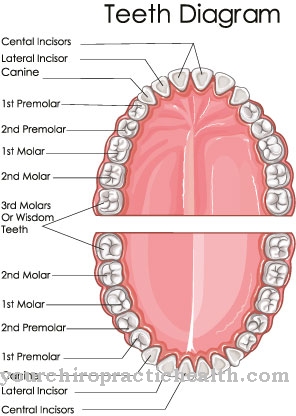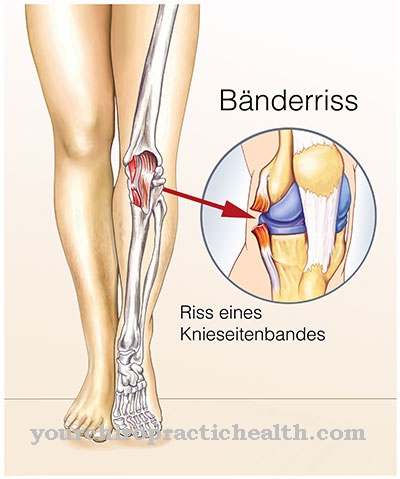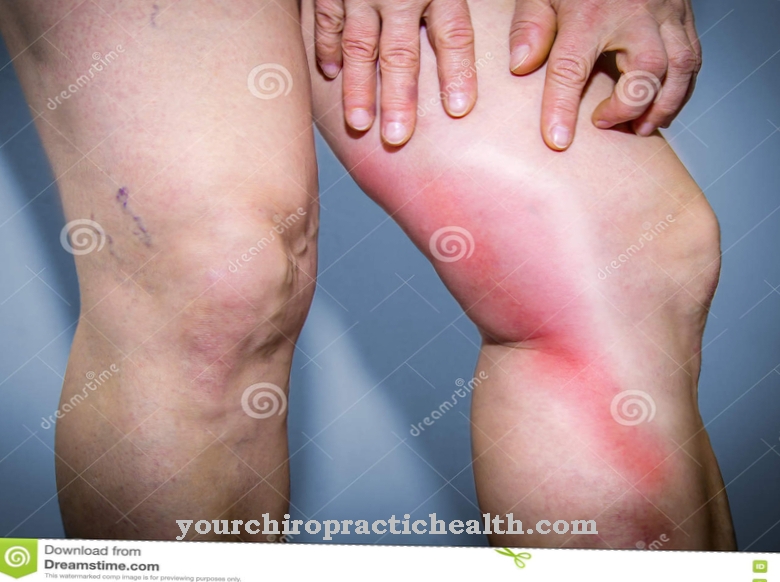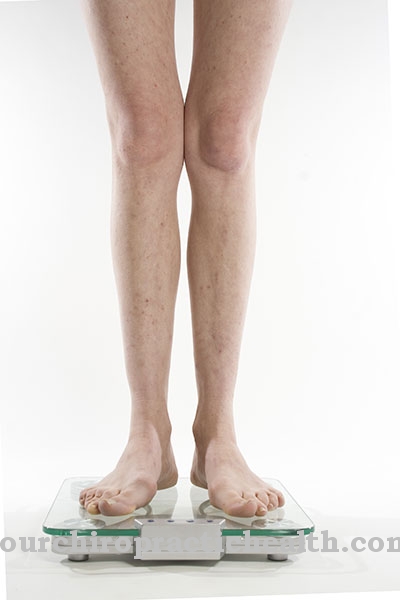The Hay-Wells Syndrome is a hereditary disease caused by a gene mutation in the TP63 gene. In addition to changes in the complexion of the skin, this disease mainly leads to undesirable developments in the skin appendages and teeth. Treatment of the disease itself is not possible, but treatment of the symptoms in question is.
What is Hay-Wells Syndrome?

© jorgecachoh - stock.adobe.com
Hay-Wells syndrome is a congenital disease. It is extremely rare and affects less than one patient in a million. The disease is named after the first two doctors who wrote the disease and its symptoms. The syndrome is characterized by a combination of three symptoms.
A clogged cleft lid shortly after birth (ankyloblepharon), ectodermal effects and a cleft lip and palate (cheilognathopalatoschisis) (cleft) occur together. The synonymous abbreviation AEC syndrome is derived from these combined symptoms. The syndrome is listed under Q82.4 on the ICD scale. It is classified as a type of ectodermal dysplasia.
causes
The cause of Hay-Wells syndrome is a gene mutation. The TP63 gene, which is located at the 3q28 gene location, is affected. The inheritance of this hereditary disease is autosomal dominant. Both women and men can be affected by the syndrome.
The prerequisite is a parent who inherits this gene mutation. Only one case was recorded that suggests a mosaic form of the syndrome, i.e. in which it can be assumed that no parent has this gene mutation.
TP-63 stands for the tumor protein 63, which belongs to the long arm of chromosome 3. This gene mutation causes keratinocytes to develop, which cannot interact with melanocytes. Accordingly, the protein exchange of the patient is significantly disturbed. The consequences are abnormalities in hair and nail growth and poor development of the teeth.
Symptoms, ailments & signs
The tissue that adjoins the outer cell layer is primarily affected by Hay-Wells syndrome. In particular, it includes hair, skin and nails. The most obvious signs are the clogged eyelid, cleft lip and palate, and the ectodermal effects.
The cleft lid is the symptom that differentiates the disease from other symptoms that affect the skin's appearance. The lids are not closed, but they have grown together like strands. The irregular hair growth is due to inflammation of the scalp. The inflammation on the surface of the skin can cause itching or pain.
Due to their deformity, the nails are also more susceptible to nail diseases, which in turn can lead to pain. The dental apparatus of the affected patients is at an increased risk of tooth decay. However, Hay-Wells syndrome has the greatest influence on the psyche of the patient, as the accumulation of symptoms causes the appearance to deviate from many different beauty standards. This leads to decreased self-esteem.
Diagnosis and course
Hay-Wells syndrome is primarily diagnosed by taking a medical history. The following characteristics are decisive clues: The patient has wiry hair, little scalp hair and infections that can be seen on the scalp; the patient has nail dystrophy; the patient sweats little or not at all.
It is possible that the eyelid is sticky after giving birth; the patient has fewer teeth than usual; a hypoplasia in the upper jaw and a cleft lip and palate. The interplay of various symptoms is important. The eczema caused by Hay-Wells syndrome can also be caused by other syndromes. However, due to the rarity of this hereditary disease, diagnosis is difficult.
While symptoms occur together in almost all patients, the course of the disease differs from patient to patient in terms of the severity of the characteristics. The characteristic triad already occurs in infancy, i.e. the three main symptoms. With increasing age it comes to the disturbed formation of the skin appendages.
There is no peak of the disease or an automatic decrease in the severity of the disease. Symptoms must be treated in order for the general condition to improve. The Hay-Wells syndrome mainly influences external, aesthetic characteristics. The quality of life is therefore not particularly restricted in independence and pain. The curtailment of the quality of life takes place primarily on the psychological level, since the self-esteem can be strong and the hereditary disease can suffer.
Complications
Due to the Hay-Wells syndrome, the patient suffers from various malformations and deformities of the body. The skin is particularly affected by the syndrome and there are still problems with the teeth. A so-called cleft palate occurs, which leads to greatly reduced aesthetics for the patient.
However, the hair and nails can also be affected by Hay-Wells syndrome and show malformations. It is not uncommon for inflammation and pain to occur on the scalp. Itching can also spread to the scalp and reduce the patient's quality of life. The malformations on the teeth also lead to pain in the mouth.
These can mainly occur when eating and drinking and thus lead to malnutrition. The risk of caries disease is also increased in the patient. In most cases, the malformations also lead to inferiority complexes and reduced self-esteem in the patient.
The cause of Hay-Wells syndrome cannot be treated. Most malformations can, however, be removed surgically.
Possible psychological complaints are also treated without complications. It is not uncommon for the patient's immune system to be weakened, so that inflammations and infections occur more often, but these can also be treated well. The syndrome does not reduce life expectancy.
When should you go to the doctor?
Since Hay-Wells syndrome does not heal itself and in most cases the symptoms worsen, an examination and treatment by a doctor is necessary in any case. This can prevent further complications. A doctor should be consulted if the person concerned suffers from severe skin discomfort for no particular reason. The symptoms can also affect your hair or nails.
Sticky eyelids or a cleft palate also indicate Hay-Wells syndrome. In many cases, the syndrome also leads to very irregular hair growth and further inflammation on the skin. Various deformities occur on the nails, which can have a negative effect on the aesthetics of the person concerned.
Hay-Wells syndrome can be diagnosed by a pediatrician or a general practitioner. However, different specialists are necessary for the treatment. Since it is a genetic disease, only symptomatic treatment is possible. Furthermore, a psychologist should always be consulted in the event of psychological complaints or depression.
Doctors & therapists in your area
Treatment & Therapy
Dermatitis on the scalp is extremely difficult to treat, but the other changes in the skin's appearance can be treated dermatologically depending on their severity. It is possible that the sticky eyelids correct themselves in rare cases, otherwise they will have to be operated on. The cleft lip and palate can only be corrected surgically together with other optical defects caused by the syndrome.
In addition, the various malformations of the skin appendages and teeth can be treated by appropriate specialists. The specialist doctor responsible decides in which context this treatment takes place. Since Hay-Wells syndrome itself is caused by a gene mutation, it is irreversible. Genetic disorders cannot simply be cured like infections or broken bones.
Accordingly, there is no therapy for the causative disease. It is only possible to treat the symptoms that occur. The chances of success of a therapy with regard to the syndrome are therefore zero. But since almost all symptoms can be treated surgically or with medication, at least one treatment of these is advisable. In addition to treating the symptoms, psychological support for those affected and their relatives is recommended.
Outlook & forecast
Since Hay-Wells syndrome is a very rare disease, something can be said about the symptoms and external manifestations. However, a general long-term forecast is not yet possible. To date, 50 cases of this disease have been described. It is probably an autosomal dominant gene mutation that usually occurs sporadically. It is also assumed that the prevalence is around 1: 1,000,000. Life expectancy does not seem to be restricted.
Typical features include an agglomeration and sticking of the eyelid clefts, a cleft lip and palate, and other ectodermal defects. The other ectodermal defects are characterized, among other things, by nail malformations, lack of urethral occlusion, enormously reduced perspiration, malformation of teeth and chronic inflammation of the scalp. The hair growth is sparse and wiry. In very rare cases, alveoli can also be fused together. These variable symptoms make it very difficult to make a general prognosis for the course of the disease.
Hay-Wells syndrome cannot be cured because it is genetic. However, symptomatic treatment is possible. The cleft lip and palate can be surgically corrected. A canthoplasty can also be used to adjust the eyelids. These cosmetic measures can improve the quality of life of the affected patient. At the same time, psychological counseling is recommended in order to counteract any threat of social exclusion.
prevention
Since Hay-Wells syndrome is an inherited gene mutation, preventive measures are not possible. Only early tests by the parents and prenatal examinations can provide information about whether the unborn child is at risk of developing Hay-Wells syndrome.
Aftercare
Since Hay-Wells syndrome is a hereditary disease, there are few, and sometimes no, follow-up measures available to those affected. The disease cannot be completely cured with it, so that the patient depends above all on early detection of the symptoms so that there are no complications in further life.
If you want to have children, genetic counseling can be useful to prevent the recurrence of Hay-Wells syndrome in the children. As a rule, the syndrome does not have a negative impact on the patient's life expectancy. The complaints are usually corrected by surgery. There are no particular complications and the symptoms are usually completely alleviated.
After such an operation, those affected should rest and take care of their bodies. Since Hay-Wells syndrome can also lead to psychological upsets or even depression, it is often very useful to have loving conversations with your own family or with your parents. These should be done especially with children. The further course itself depends very much on the exact type and severity of the symptoms, so that no general prediction can be made.
You can do that yourself
With Hay-Wells syndrome there is no way of prevention. However, if the syndrome occurs, parents can change to genetic counseling and thus weigh up the risk of developing the syndrome in the child. The possibilities for self-help are usually very limited, so that those affected are primarily dependent on medical treatment.
Due to the many malformations, the patients are dependent on intensive and soulful care. The care of relatives or parents has a very positive effect on the course of the disease. The carers need a lot of calm and patience.
Some malformations can be corrected. Correction is particularly recommended if it can alleviate aesthetic complaints. In the case of mental illness or depression, talking to other sufferers of Hay-Wells Syndrome can help. Discussions with parents or with the partner can also alleviate possible inferiority complexes. The psychological treatment is often also suitable for parents and relatives, as they can also suffer from psychological complaints.
Due to the weakened immune system of the patient, sufficient hygiene must be observed. This can prevent infections and inflammation.













.jpg)

.jpg)
.jpg)











.jpg)